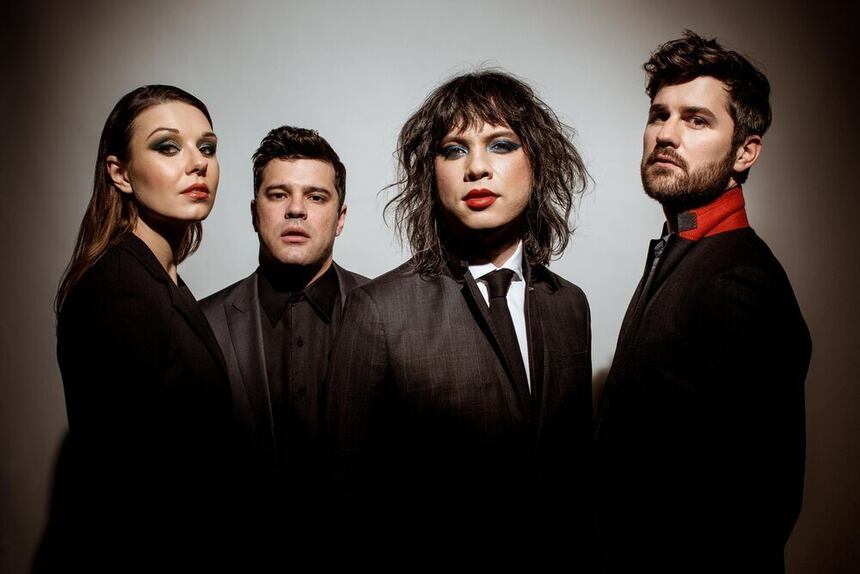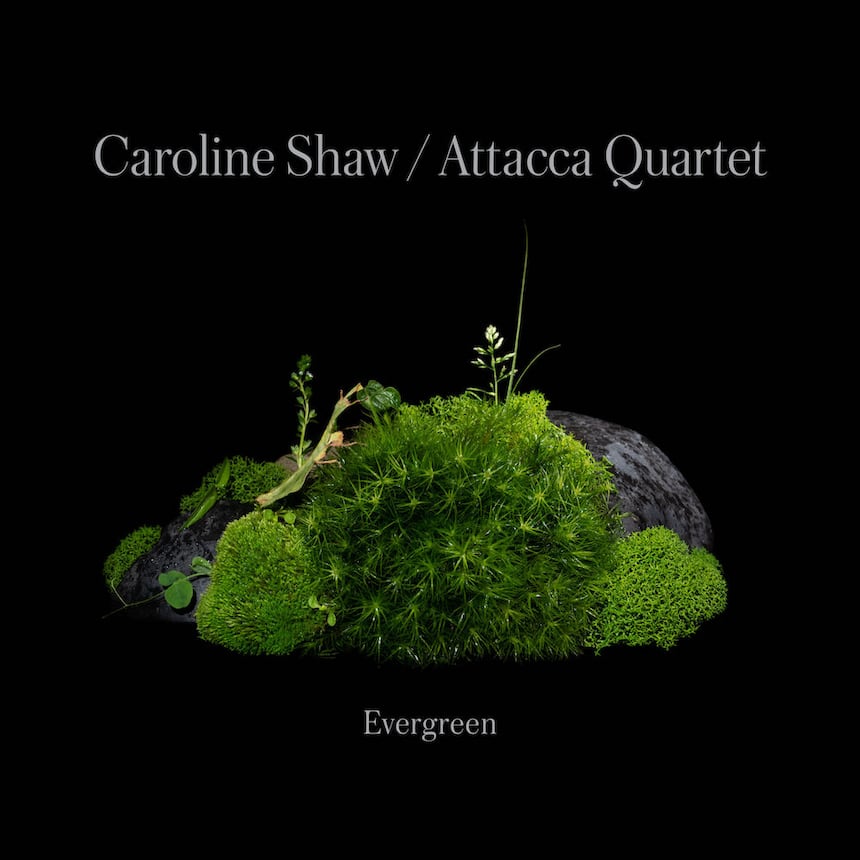In March 2019, the Attacca Quartet released Orange, an album devoted entirely to the composer Caroline Shaw. Three years later, you’re collaborating with her again: what made you want to dive back into her repertoire? And does this second chapter mark the beginning of a long-term collaboration?
Well, Evergreen is actually more like the eighth chapter! Caroline Shaw and Attacca have been friends and colleagues for a long time—long before Orange was released. Orange was the first album we dedicated to her, but it was the culmination of years and years of close collaboration. Over the years, we've been lucky enough to play with her and for her in every possible configuration: as a composer, a singer, a violinist, a violist... and above all, as a friend! (laughs) When we were preparing Orange, we worked on a lot of her compositions before choosing the ones that would appear on the record. Once we’d chosen which ones to include, we still had a lot of material left, pieces that we’d mastered and were just waiting to be recorded for a future record. In this way, Evergreen isn’t so much a "return to" for our quartet, but rather a logical continuation. This project was particularly exciting because Caroline wasn’t only there to direct us or share her vision as a composer, but also to perform these pieces alongside us as a singer.
Orange received the award for Best Chamber Music Performance at the 2020 Grammy Awards. The album was unanimously well-received by critics and achieved an almost unheard-of number of streams for a contemporary music album. I imagine that with that kind of exposure, there must be some pressure to do just as well or better this time...
I think every artist experiences pressure differently, but as far as I'm concerned, there’ll always be an inherent pressure to do your best, no matter the circumstances. However, unlike live performance, the studio gives you the huge luxury of being able to record as many takes as you need. Personally, my time in the studio was mostly characterised by the joy of working directly with Caroline on vocals and with my colleagues in the quartet, so I didn’t feel much pressure. As for the media exposure, nobody anticipated an “Orange 2”, so nothing was really expected of us, and we were able to quietly get on with our work.

The Attacca quartet's albums usually revolve around a strong concept. Of all Joys evoked the joy of reunion after months of separation due to the lockdown, Real Life was a vast sonic exploration of the electronic world... What is Evergreen about? What does this record tell us?
The common thread running through the album is man's interaction with nature—even if not all the pieces in the programme make direct reference to it. 'The Evergreen', the central composition from which the album gained its name, is a poem dedicated to a thousand-year-old tree that Caroline happened upon during a walk on the west coast of Canada. 'Blue Print' is a sort of mischievous dialogue between Caroline and Beethoven—you could call it a dialogue 'across the ages'. Meanwhile, in 'And So' she pays tribute to her friend’s spouse, who has sadly passed away. In each of these works, whether it's addressed to a human being or a tree, whether it's an implicit or explicit conversation, I think the overall point is to reflect on how music can respond to people and nature.
One of the novelties of this record is Caroline Shaw’s involvement as a vocalist on three tracks. The perfect synergy between her voice and the instruments is simply dazzling, with neither of the two parts ever claiming the leading role. You all move forward in the same breath, in a rubato that’s so fascinating because it feels so free...
Thank you very much; your comments are really great to hear! I'm happy to hear that this synchrony is perceptible when listening, as that's exactly the effect we were trying to achieve. On the tracks where Caroline sings, there was no real hierarchy between her and us. Our sound engineer rented an extremely powerful microphone for her, which allowed her to record in the middle of us instead of isolating herself in a separate booth. In this way, we felt more like a quintet than a quartet with a soloist.
There’s also a moving cover of 'Other Song', a song originally composed by Caroline Shaw on her album Let the Soil play Its Simple Part with the So Percussion ensemble. This new version for strings is radically different from the original; in fact, it sounds like a new song rather than a cover. Were you involved in the re-orchestration process?
We didn't participate in the actual writing process. Still, if ideas came to us—particularly if they aimed to make a composition more readable or expressive—Caroline was quite open to taking these suggestions into account. In terms of 'Other Song', she already had a very clear vision of what she wanted to achieve, but during the creation of a piece, the musicians often have technical questions regarding the interpretation of certain passages. Take the climax of this piece, for example; there’s this beautiful whirlwind of sound that comes together on the word 'find'. This climax wasn’t originally in the score, but it's something we came to through trial and error as we searched for the optimum manner of expression. I think the fact that the composer was also performing alongside us forced us to think like composers, not just instrumentalists.
Going back to what you said about the radically different nature of this new version, Caroline is the kind of musician who’s constantly switching things up. She's not interested—and neither are we!—in doing the same thing over and over again, so she changed the orchestration and the mood. We changed some aspects too; I remember the festival where we first played the pizzicato ending… Unfortunately, it sounded too flat, so we swapped it for an arco playing.
Attacca Quartet - Caroline Shaw's "Plan & Elevation: IV. The Orangery"
Nonesuch RecordsThe Attacca Quartet is usually recognised for its work on contemporary music, but you claim that you’re also inspired by music from more distant times. This album closes with a 12th-century poem in which your instruments take on a completely different tone. What relationship does Attacca have with early music?
If you ask any of us—especially Andrew and Amy, the founders of the quartet—we’ll tell you that Attacca is rooted in Haydn’s music. Of course, we’re inspired by baroque music, but primarily for its instrumental techniques rather than its aesthetic. Our aim is to extract the sonic textures of that era and infuse them into more modern writing. For example, we often use baroque bows to lighten the tone, creating a sound that’s different to that created by modern bows. In 'Cant voi l'aube' (When I see the dawn), the poem you're referring to is a poem written in the 12th century, but the music is absolutely contemporary: the aim is to convince the audience that it was written at the same time as the text.
The Attacca Quartet doesn’t seem fixed on specialising in just one genre or period: how would you define the ensemble’s artistic path?
If you specialise in anything, it's music you love! It's as simple as that (laughs). We're willing to play any composer's work as long we can keep exploring different sounds and techniques in the process. We created this album because we love Caroline Shaw; we love everything she does and just want to be a part of it. If you look at the discography our quartet has accrued since its inception, you'll see that a lot of our work is based on unique, remarkable composers. Our leitmotiv is to take a deep dive into the aesthetics of a composer and provide a comprehensive overview of them. You learn a lot by digging into the very core of a composer's aesthetic, both about them and the time they live in. I'm thrilled that the quartet has maintained this eclecticism, though I don't think it makes us all-encompassing. When we embark on a new project, we give it our all! I think the public is more than capable of understanding the intersections and bridges we build between genres and aesthetics.

